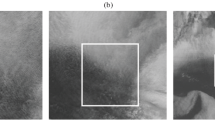Abstract
A statistical model is proposed which describes the texture of the images of 25 types of clouds from the MODIS satellite data with the spatial resolution of 250 m. A technique is presented which compiles the sets of image segments with typical textures for different cloud types. To describe the texture, the following statistical methods are applied: Gray-Level Co-occurrences Matrix, Gray-Level Difference Vector, and Sum and Difference Histogram. The correlation analysis is used to form the sets of informative textural features for the images of different cloud types. Two-parameter distribution laws and the estimates of their parameters are presented which describe fluctuations in the efficient set of textural features of different cloud types.
Similar content being viewed by others
References
V. G. Astafurov, T. V. Evsyutkin, K. V. Kur’yanovich, and A. V. Skorokhodov, “Statistical Model of the Texture of Images of Various Cloudiness Types from MODIS Data,” Sovremennye Problemy Distantsionnogo Zondirovaniya Zemli iz Kosmosa, No. 4, 10 (2013) [in Russian].
V. G. Astafurov and A. V. Skorokhodov, “Multi-layer Cloud Classification from MODIS Data Using Neural Network Technology and Fuzzy Logic Approach,” Sovremennye Problemy Distantsionnogo Zondirovaniya Zemli iz Kosmosa, No. 6, 12 (2015) [in Russian].
V. G. Astafurov and A. V. Skorokhodov, “Segmentation of Cloud Satellite Images by Textural Features Based on Neural Network Technologies,” Issledovanie Zemli iz Kosmosa, No. 6 (2011) [in Russian].
D. P. Bespalov et al., The Atlas of Clouds, Ed. by L. K. Surygin (D’ART, St. Petersburg, 2011) [in Russian].
E. V. Volkova and A. B. Uspenskii, “Estimation of Cloud Cover Parameters from METEOSAT-9 Geostationary Meteorological Satellite Data for Day and Night Time,” Sovremennye Problemy Distantsionnogo Zondirovaniya Zemli iz Kosmosa, No. 3, 7 (2010) [in Russian].
R. Duda and P. Hart, Pattern Classification and Scene Analysis (Mir, Moscow, 1970) [Transl. from English].
N. Yu. Zakhvatkina, V. Yu. Aleksandrov, A. A. Korosov, and O. M. Johanssen, “Sea Ice Classification Using ENVISAT ASAR Images,” Sovremennye Problemy Distantsionnogo Zondirovaniya Zemli iz Kosmosa, No. 1 (2009) [in Russian].
A. I. Kobzar’, Applied Mathematical Statistics for Engineers and Researchers (Fizmatlit, Moscow, 2006) [in Russian].
The Code for Operational Transfer of Data of Surface Meterological Observations from the Roshydromet Station Network (KN-01 SYNOP), Ed. by N. P. Fakhrutdinova (Federal Service for Hydrometeorology and Environmental Monitoring, Moscow, 2013) [in Russian].
N. V. Kolodnikova, “A Review of Textural Features for the Probtems of Pattern Recognition,” Doklady Tomskogo Gosudarstvennogo Universiteta Sistem Upravleniya i Radioelektroniki, No. 1, 9 (2004) [in Russian].
Clouds and Cloudy Atmosphere. Handbook, Ed. by I. P. Mazin and A. Kh. Khrgian (Gidrometeoizdat, Leningrad, 1989) [in Russian].
S. Osovskii, Neural Networks for Data Processing (Finansy i Statistika, Moscow, 2002) [Transl. from Polish].
S. Haykin, Neural Networks: A Comprehensive Foundation (Izdatel’skiiDom Vil’yams, Moscow, 2008) [Transl. from English].
R. M. Haralick, “Statistical and Structural Approaches to Texture,” Proc. IEEE, No. 5, 67 (1979) [Transl. from English].
R. L. Bankert, C. Mitrescu, S. W. Miller, and R. H. Wade, “Comparison of GOES Cloud Classification Algorithms Employing Explicit and Implicit Physics,” J. Appl. Meteorol. Climatol., 48 (2009).
D. Gabor, W. P. L. Wilby, and R. Woodcock, “A Universal Non-linear Filter, Predictor, and Simulator Which Optimizes Itself by a Learning Process,” Proc. IEEE, 8 (1960).
R. M. Haralick, K. Shanmugam, and I. Dinstein, “Textural Features for Image Classification,” IEEE Trans. Syst., Man, and Cybern., No. 6, 3 (1973).
Y. Liu, J. Xia, C.-X. Shi, and Y. Yang, “An Improved Cloud Classifcation Algorithm for China’s FY-2C Multi-channel Images Using Artificial Neural Network,” Sensors, 9 (2009).
Math Wave Technologies EasyFit—Introduction to EasyFit [Online]. EasyFit—Distribution Fitting Software. Math Wave Technologies—Data Analysis and Simulation, 2010, http://www.mathwave.com/help/easyfit/index.html (Accessed 2013).
M. Unser, “Sum and Difference Histograms for Texture Classification,” IEEE Trans. Pattern Analysis and Machine Intelligence, No. 1, 8 (1986).
J. S. Weszka, C. R. Dyer, and A. Rosenfeld, “A Comparative Study of Texture Measures for Terrain Classification,” IEEE Trans. Syst., Man, and Cybern., No. 4, 6 (1976).
Author information
Authors and Affiliations
Corresponding author
Additional information
Original Russian Text © V.G. Astafurov, K.V. Kur’yanovich, A. V. Skorokhodov, 2017, published in Meteorologiya i Gidrologiya, 2017, No. 4, pp. 53-66.
About this article
Cite this article
Astafurov, V.G., Kur’yanovich, K.V. & Skorokhodov, A.V. A statistical model for describing the texture of cloud cover images from satellite data. Russ. Meteorol. Hydrol. 42, 248–257 (2017). https://doi.org/10.3103/S1068373917040057
Received:
Accepted:
Published:
Issue Date:
DOI: https://doi.org/10.3103/S1068373917040057




